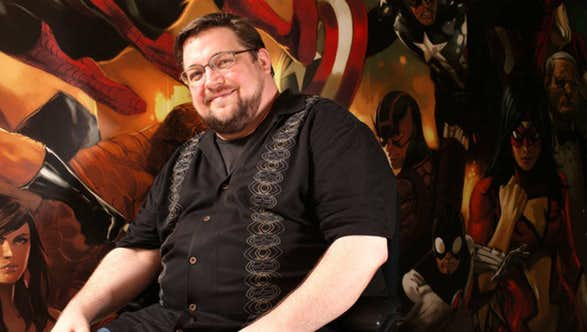
True to its name, Marvel’s “Meet the New Editor in Chief” panel Saturday afternoon at C2E2 in Chicago was an informal chat with C.B. Cebulski about his life and career before being named Editor-in-Chief of Marvel Comics in November 2017.
“I loved three things when I was growing up: I loved Disney, I loved Marvel, and I loved Star Wars,” Cebulski said. “It was like Marvel reached into my head and created a company around it.” When he was about five or six years old, Cebulski recalled, he hated getting his hair cut—until his grandfather got him a comic book from the dime store next to the barbershop. “I don’t remember what the first few were, but I specifically remember X-Men #121,” he said. “I just remember being blown away by the story and the art, and that was the first time I realized they were tied together. From that point in I was hooked.”
RELATED: C2E2: Marvel Next Big Thing Panel with Aaron, Soule, Cebulski and More
His grandmother let him pick out some comics from Marvel’s subscription service and he loved getting comics in the mail. Eventually, he discovered comic shops. “I remember when I got my first pull box. I must have been around 11 or 12. I had that pull box until I went to college.” He worked in another comic shop while he was in college.
After college, Cebulski moved to Japan for three years, and on his return went to work at now-defunct media company Central Park Media, where he started the manga division. After he left CPM, he started a company called Fanboy that was looking for artists and writers to do indie comics.
Cebulski and writer/artist Skottie Young, who served as the panel’s moderator, first met 20 years ago in Chicago, when Cebulski was scouting artists and writers for Image Comics at a comics convention in Chicago. “I was going through Artists’ Alley, meeting a bunch of different people, talking to folks,” Cebulski said. “I came across this guy’s portfolio and it stood out to me. Like wow, that’s dynamic art. There was only one comic book in there, but it was just one of those things where you see something and you know someone’s got it.”
“C.B. has this insane ability to see something that might not be there yet but will be there soon,” Young said. “I can honestly say I was not good enough. I really, really was not there yet, but CB has this ability to say ‘He or she might not be there yet, but I know what they are going to be.’”
Cebulski and Young began talking about stories, and Young got a book greenlit at Image around the same time that Cebulski began freelancing at Marvel. He worked on the Spider-Man manga and was a consultant for the Marvel Mangaverse, a line of Marvel comics by American artists working in a manga-influenced style.
One evening, Cebulski called Young with some news: Artist Karl Kerschl was working on an Iceman miniseries and couldn’t do an issue for some reason — Marvel needed someone to fill in, and Cebulski had suggested Young. “C.B. calls me and he’s like, ‘Mike Marts from Marvel is going to call you. Act surprised.’” Young said. “And I’m like ‘I definitely don’t need to act surprised. I will be full-blown surprised.’ He said ‘He’s asking you to do a fill-in for this.’ Aside from the sample pages we used to get that Image book back in the day, I had never drawn a full comic book ever, so when the editor said ‘Can you turn around a 22-page comic book in three weeks?’ I was like ‘Yeah, of course, for sure. I’ll do that!’”
“After that issue came out, this is where the future C.B. was really on fire,” Young said. At the time, Young was working at the Chicago restaurant chain Ed Debevic’s, and Cebulski would often call him at night, when he was out with Marts and other Marvel editors. “We were constantly putting together pitches at 1 or 2 a.m.,” Young said. “He’s at a bar, I just got home from my shift, and we were just constantly putting together [pitches].”
Marvel hired Cebulski as an editor in 2003. He left to pursue a writing career in 2006 and returned within the year. (Young and Cebulski did not discuss the fact that Cebulski had written comics for Marvel and other publishers under the pseudonym “Akira Yoshida,” something Cebulski only admitted publicly after he was hired as Editor-in-Chief.)
When Cebulski returned, Joe Quesada remarked that he had an eye for talent. “Joe told me one time, ‘When Axel Alonso’ — who was the Executive Editor at that time — ‘walks into a room, every writer in the room wants to talk to him because he’s one of the best story editors out there.’ People knew he had hired a lot of the different great writers that came to Marvel. I think someday you could be the same for talent.’”
Cebulski and David Bogart established the Talent Management department. “It was not just getting artists into Marvel but it was working with the editorial team to figure out where artists were best suited, where they could move around, how to best advance their careers and move them up the ladder, so identify not just from outside Marvel but once inside Marvel, how we are going to manage their careers.”
After Marvel was acquired by Disney, Disney asked him to visit its different offices and give a “Marvel 101” lesson to the staff. “We started with the basics, Peter Parker is Spider-Man, Bruce Banner is Hulk,” Cebulski said, “and walked them through the main characters, down to the corporate philosophy of who we are, how we operate, and that Marvel is more than just characters with costumes and powers, it’s really about the people under the mask. It’s about relatability. It’s about the world outside your window.” As those lessons evolved, Cebulski began to move from talent management into brand management, and two years ago hoved to China to promote Marvel’s comics and other products to people who were only aware of the movies.
When the possibility first came up that he could be named to the Editor-in-Chief position, Cebulski said, he read Sean Howe’s Marvel Comics: The Untold History. “When you are looking to the future, the most important thing is you have to look back and walk in the footsteps of those that came before us,” he said. “There is no job description for what Editor-in-Chief is, and that’s one of the things I learned from that book… Everyone has their own way of putting their own stamp on it.”
RELATED: C2E2: Brian Michael Bendis & Mark Millar One on One
Cebulski’s take on the job is that he’s not the boss. “I’m not the coach, I’m the quarterback,” he told his editorial team. “I’m there on the playing field with you, working together to find the best possible plays to make machine move forward and to make the best possible content for it.”
Cebulski says he prefers slogans to manifestos, and the most important slogan is “Talent first.” Comics are at the heart of what Marvel does, and talent — including creators and editors — is essential to making them. “If you take care of the talent, you will get the best stories and the best art,” he said. “And if they are motivated, the books will, hopefully, come out on time.”
Catch up with CBR’s coverage from C2E2 2018!

